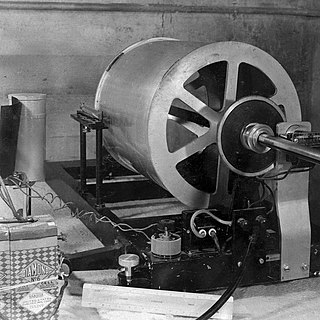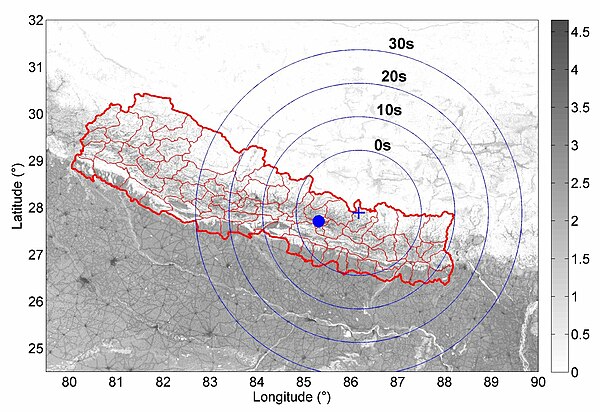
An earthquake – also called a quake, tremor, or temblor – is the shaking of the Earth's surface resulting from a sudden release of energy in the lithosphere that creates seismic waves. Earthquakes can range in intensity, from those so weak they cannot be felt, to those violent enough to propel objects and people into the air, damage critical infrastructure, and wreak destruction across entire cities. The seismic activity of an area is the frequency, type, and size of earthquakes experienced over a particular time. The seismicity at a particular location in the Earth is the average rate of seismic energy release per unit volume.

The epicenter, epicentre, or epicentrum in seismology is the point on the Earth's surface directly above a hypocenter or focus, the point where an earthquake or an underground explosion originates.

A seismometer is an instrument that responds to ground displacement and shaking such as caused by quakes, volcanic eruptions, and explosions. They are usually combined with a timing device and a recording device to form a seismograph. The output of such a device—formerly recorded on paper or film, now recorded and processed digitally—is a seismogram. Such data is used to locate and characterize earthquakes, and to study the internal structure of Earth.

An accelerometer is a device that measures the proper acceleration of an object. Proper acceleration is the acceleration of the object relative to an observer who is in free fall. Proper acceleration is different from coordinate acceleration, which is acceleration with respect to a given coordinate system, which may or may not be accelerating. For example, an accelerometer at rest on the surface of the Earth will measure an acceleration due to Earth's gravity straight upwards of about g ≈ 9.81 m/s2. By contrast, an accelerometer that is in free fall will measure zero acceleration.

The Japan Meteorological Agency (JMA) Seismic Intensity Scale is a seismic intensity scale used in Japan to categorize the intensity of local ground shaking caused by earthquakes.

Hiroo Kanamori is a Japanese-American seismologist who has made fundamental contributions to understanding the physics of earthquakes and the tectonic processes that cause them.

Gravimetry is the measurement of the strength of a gravitational field. Gravimetry may be used when either the magnitude of a gravitational field or the properties of matter responsible for its creation are of interest. The study of gravity changes belongs to geodynamics.
Seismic magnitude scales are used to describe the overall strength or "size" of an earthquake. These are distinguished from seismic intensity scales that categorize the intensity or severity of ground shaking (quaking) caused by an earthquake at a given location. Magnitudes are usually determined from measurements of an earthquake's seismic waves as recorded on a seismogram. Magnitude scales vary based on what aspect of the seismic waves are measured and how they are measured. Different magnitude scales are necessary because of differences in earthquakes, the information available, and the purposes for which the magnitudes are used.

An earthquake warning system or earthquake alarm system is a system of accelerometers, seismometers, communication, computers, and alarms that is devised for rapidly notifying adjoining regions of a substantial earthquake once one begins. This is not the same as earthquake prediction, which is currently not capable of producing decisive event warnings.
Body-waves consist of P-waves that are the first to arrive, or S-waves, or reflections of either. Body-waves travel through rock directly.

In Japan, the Earthquake Early Warning (EEW) is a warning issued when an earthquake is detected by multiple seismometers. These warnings are primarily issued by the Japan Meteorological Agency (JMA), with guidance on how to react to them.
The Richter scale, also called the Richter magnitude scale, Richter's magnitude scale, and the Gutenberg–Richter scale, is a measure of the strength of earthquakes, developed by Charles Richter in collaboration with Beno Gutenberg, and presented in Richter's landmark 1935 paper, where he called it the "magnitude scale". This was later revised and renamed the local magnitude scale, denoted as ML or ML .
The 2007 Alum Rock earthquake occurred on in Alum Rock Park in San Jose, in the U.S. state of California. It measured 5.6 on the moment magnitude scale and had a maximum Mercalli intensity of VI (Strong). The event was then the largest in the San Francisco Bay Area since the 1989 Loma Prieta earthquake, which measured 6.9 on the moment magnitude scale, but was later surpassed by the 2014 South Napa earthquake. Ground shaking from the Alum Rock quake reached San Francisco and Oakland and other points further north. Sixty thousand felt reports existed far beyond Santa Rosa, as far north as Eugene, Oregon.

The Swiss Seismological Service at ETH Zurich is the federal agency responsible for monitoring earthquakes in Switzerland and its neighboring countries and for assessing Switzerland's seismic hazard. When an earthquake happens, the SED informs the public, authorities, and the media about the earthquake's location, magnitude, and possible consequences. The activities of the SED are integrated in the federal action plan for earthquake precaution.
The 1992 Cape Mendocino earthquakes occurred along the Lost Coast of Northern California on April 25 and 26. The three largest events were the M7.2 thrust mainshock that struck near the unincorporated community of Petrolia midday on April 25 and two primary strike-slip aftershocks measuring 6.5 and 6.6 that followed early the next morning. The sequence encompassed both interplate and intraplate activity that was associated with the Mendocino Triple Junction, a complex system of three major faults that converge near Cape Mendocino. The total number of aftershocks that followed the events exceeded 2,000.

An inertial measurement unit (IMU) is an electronic device that measures and reports a body's specific force, angular rate, and sometimes the orientation of the body, using a combination of accelerometers, gyroscopes, and sometimes magnetometers. When the magnetometer is included, IMUs are referred to as IMMUs.
Recent advances are improving the speed and accuracy of loss estimates immediately after earthquakes so that injured people may be rescued more efficiently. "Casualties" are defined as fatalities and injured people, which are due to damage to occupied buildings. After major and large earthquakes, rescue agencies and civil defense managers rapidly need quantitative estimates of the extent of the potential disaster, at a time when information from the affected area may not yet have reached the outside world. For the injured below the rubble every minute counts. To rapidly provide estimates of the extent of an earthquake disaster is much less of a problem in industrialized than in developing countries. This article focuses on how one can estimate earthquake losses in developing countries in real time.

ShakeAlert is an earthquake early warning system (EEW) in the United States, developed and operated by the United States Geological Survey (USGS) and its partners. As of 2021, the system issues alerts for the country's West Coast. It is expected that the system will be expanded to other seismically active areas of the United States in the future. ShakeAlert is one of two EEW systems available in the United States, with Google's Android Earthquake Alerts System being the other.
The 1995 Menglian earthquake or 1995 Myanmar–China earthquake occurred on 12 July at 05:46:43 local time in the Myanmar–China border region. The earthquake had an epicenter on the Myanmar side of the border, located in the mountainous region of Shan State. It registered 7.3 on the Chinese surface wave magnitude scale (Ms ) and 6.8 on the moment magnitude scale (Mw ). With a maximum Mercalli intensity assigned at VIII, it killed 11 people and left another 136 injured. Over 100,000 homes in both countries were destroyed and 42,000 seriously damaged. Some damage to structures were also reported in Chiang Mai and Chiang Rai, Thailand. The low death toll from this earthquake was attributed to an early warning issued prior to it happening. Precursor events including foreshocks and some seismic anomalies led to an evacuation of the area before the mainshock struck. It is thought to be one of the few successfully predicted earthquakes in history.

The Wood–Anderson seismometer is a torsion seismometer developed in the United States by Harry O. Wood and John August Anderson in the 1920s to record local earthquakes in southern California. It photographically records the horizontal motion. The seismometer uses a pendulum of 0.8g, its period is 0.8 seconds, its magnification is 2,800 times, and its damping constant is 0.8. Charles Francis Richter developed the Richter magnitude scale using the Wood–Anderson seismometer.














